Dermatophyllum secundiflorum
The intoxicating fragrance of Texas mountain laurel is enough to cause drivers to slam on the brakes or dog walkers to abruptly stop short, giving poor Fido whiplash.
Famed TV chef Emeril Lagasse used to lament the non-invention of “smell-o-vision.” I wish for “smell-o-website” so I could share with you the heavenly scent produced by the pretty purple flowers of these shrubs.
Even better, this is one of those plants that disperses its aroma several feet; I can smell my neighbors’ plant’s blooms from across the street.

We link to vendors to help you find relevant products. If you buy from one of our links, we may earn a commission.
Some compare the scent to grape Kool-Aid, soda, or gum, but the fragrance is deeper, richer, and more floral than the artificial aroma of processed food.
Read on to learn more!
What You’ll Learn
What Is Texas Mountain Laurel?
Texas mountain laurel’s glossy, dark green leaves are evergreen and leathery. The large clusters – as long as six inches – of showy flowers appear in early spring, and sadly, bloom for just a few weeks before withering and taking their scent away.
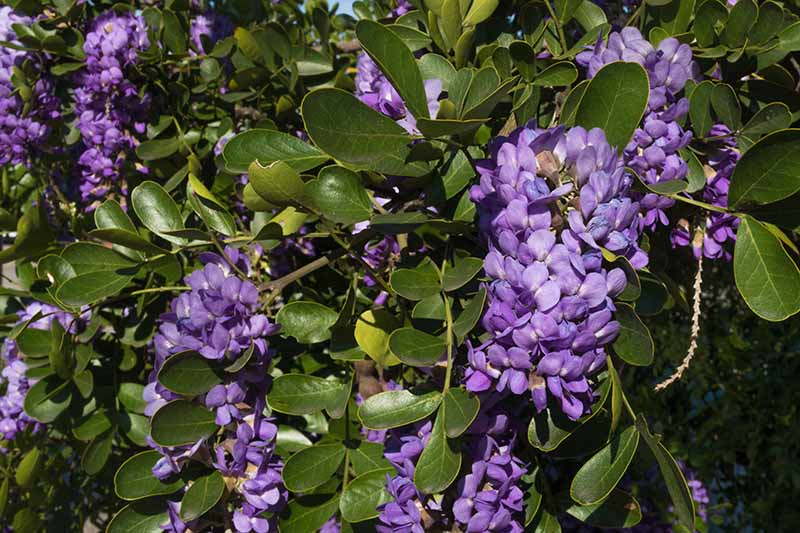
Though these slow-growing plants can be kept pruned to a shrub size, most often they are allowed to mature into small treelike forms 10 feet wide and 15 feet high, multi- or single-trunked.
Older specimens in their natural habitat can reach 30 to 50 feet tall at maturity.
But the breathtaking bouquet is just one of the charms of this Texas native, which is hardy to USDA Hardiness Zone 7b.
This plant has several common-name aliases, including coral bean, hot bean, mescal bean, mescal bean sophora, frigolito, frijollito, frijolillo, coral bean, big-drunk bean, and colorin.
Some of these are reflective of the plant’s native territory, which in addition to central, southern, and western Texas, also includes New Mexico and northern Mexico.

But, Texas being Texas, we had to stamp it with our own name, of course.
Previously known interchangeably as Sophora secundiflora and Calia secundiflora, recent phylogenetic studies have led to the reclassification of certain members of the Sophora genus into Dermatophyllum – a taxonomic synonym for Calia.
You will still see Texas mountain laurel referred to as S. secundiflora or C. secundiflora in some places.
Lovely as they are, the flowers of Texas mountain laurel are toxic to humans and animals, as are the plant’s seed pods and leaves. The seeds – called mescal beans – are a pretty orange-red color and are sometimes used as necklace beads.
Cultivation and History
A quick note: those of us here in Texas understand there’s another plant that calls itself “mountain laurel.” Nevertheless, our laurel is unrelated to Kalmia latifolia, a member of the heather family, Ericaceae, whereas ours is in the pea family, Fabaceae.
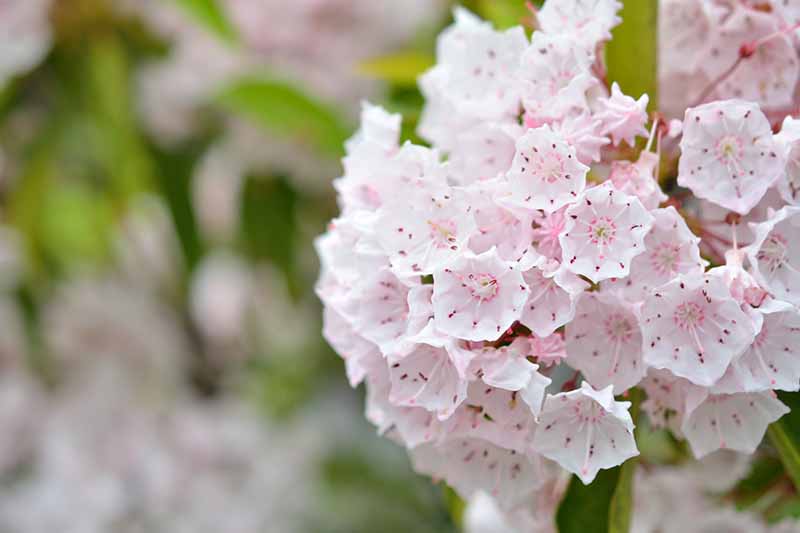
Toxic mescal beans were used ritually by indigenous peoples of the Central and Southern plains tribes for their psychoactive properties. Evidence of their use can be found in numerous archaeological sites in Texas and Mexico, and shows that these cultures also used the colorful seeds decoratively.
The mescal beans contain a number of poisonous quinolizidine alkaloids, including cystine, a narcotic alkaloid with a similar molecular structure to that of nicotine.
However, in spite of the name, they do not contain the hallucinogenic alkaloid mescaline, found in the peyote cactus. Nor should they be confused with the alcoholic beverage mezcal, which is made from the agave plant.
Propagation
These plants grow slowly, so if you’re looking for an immediate statement in the landscape, you might consider purchasing a well-established specimen in a large container from a local nursery.

Texas mountain laurel does not propagate well from cuttings.
However, if you’re patient, you can grow a Texas mountain laurel from seed.
From Seed
Seeds that fall from the plant can take years to germinate, as they have extremely hard shells. But a few tricks may provide faster results, if you’d like to grow some seedlings for transplant into the garden.
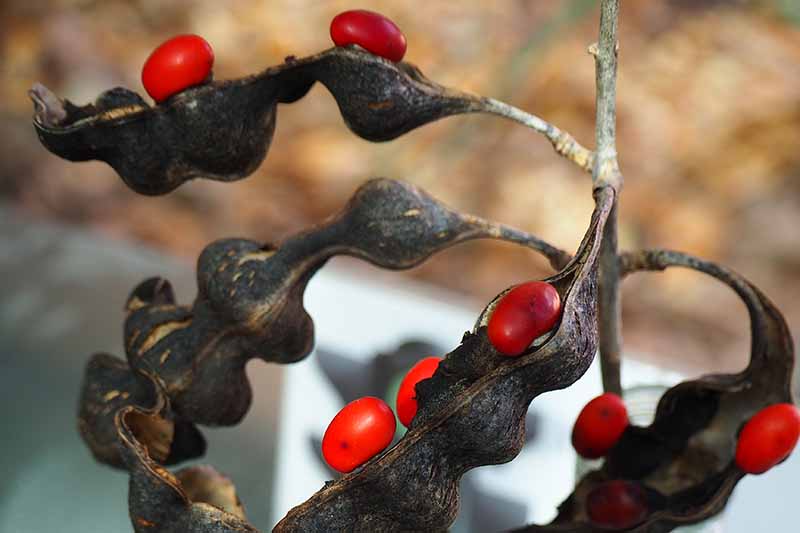
If you’re collecting seeds, pick the pods when they’re still mostly green but just starting to turn gray. The seeds will be pale pink and their shells will be relatively soft.
Sow these in gallon-sized containers with holes in the bottom filled with well-draining potting mix. Water often.
Alternatively, you can direct sow in the garden. Bury the seed about half an inch deep.
And be patient.
If someone hands you some hard, older pods, soak them in water to make it easier to break them apart and get at the seeds. With both donated and purchased seeds, chances are they’re more mature. You’ll have to scarify them before planting, as they have extremely hard shells.
As you would with morning glories, scratch them up with a knife, for example, or use sandpaper.
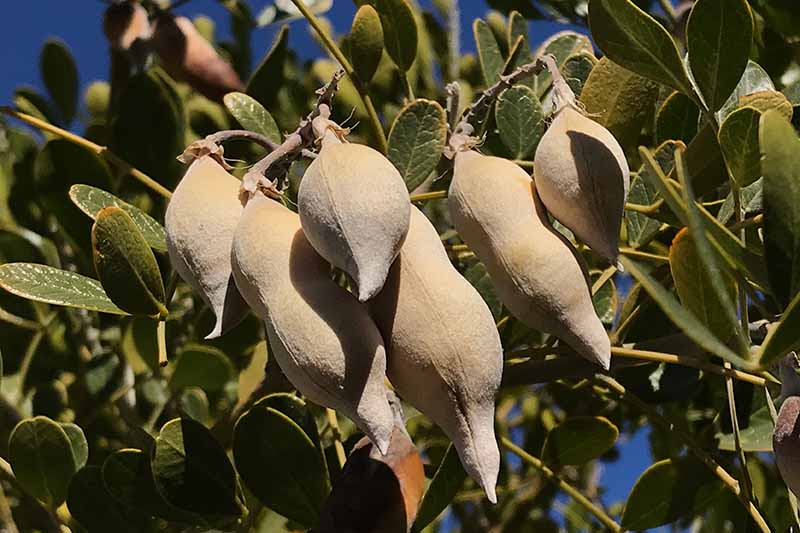
You can try soaking the seeds in warm water for two to three days, changing the water regularly to keep it tepid. This approach appears to work best if you first make a small cut in the tough outer shell.
However you plant your seeds, water them daily for the first couple of months, then about once a week for another year.
From Seedlings or Transplants
When transplanting into the ground, mix some extra calcium into the soil at the planting site to help plants get established.
Dig a hole slightly bigger than the root ball, then carefully place the root ball into the hole, and backfill with planting site soil.
Mature Texas mountain laurels have a deep root system, and they do not transplant well once established.
How to Grow Texas Mountain Laurel
Texas mountain laurel prefers alkaline, well-drained rocky soils, including those that contain limestone. They’ll do well in clay, loam, and sand, and will tolerate being planted in or near turf.

Choose a planting site in an area that gets full sun. D. secundiflorum will also tolerate light shade for part of the day.
Once established, these drought-tolerant shrubs require little to no irrigation.
They also do perfectly well with no fertilization, but in areas with very poor soil you can add a small amount of a balanced fertilizer such as NPK 10-10-10 in springtime.
Growing Tips
- Plant in a sunny spot
- Soil should be alkaline and well-draining
- Water regularly for the first year
Pruning
There is no actual need to prune Texas mountain laurel. But if you want to change its form, say, into more of a traditional tree shape, or into a more compact bush, you can do so.

Keep in mind that the blossoms only appear on year-old wood. So while you might be tempted to prune during winter dormancy, this might result in less abundant blooms.
An alternative pruning time is in the summer, after it has finished flowering. When the brutal heat strikes, like many of us, these plants will go dormant.
Prune no more than one-third of the plant at a time. First prune out any deadwood. Then cut out thin, spindly branches. There’s no need to use pruning paint.
To encourage height, prune out lower branches and leave just one, two, or three trunks. For a more shrub-like appearance, trim the upper branches.
Where to Buy Texas Mountain Laurel
If you’re looking for live plants, you can often find them in garden centers and plant nurseries in areas where they typically thrive.
Buying seeds online can be a bit hit or miss, as they may not always be viable.
Managing Pests and Disease
Let’s start with the good news. Deer leave this one alone, so nothing to worry about there.
The bad news is that this plant is plagued by Uresiphita reversalis, aka genista caterpillar or sephora worm.
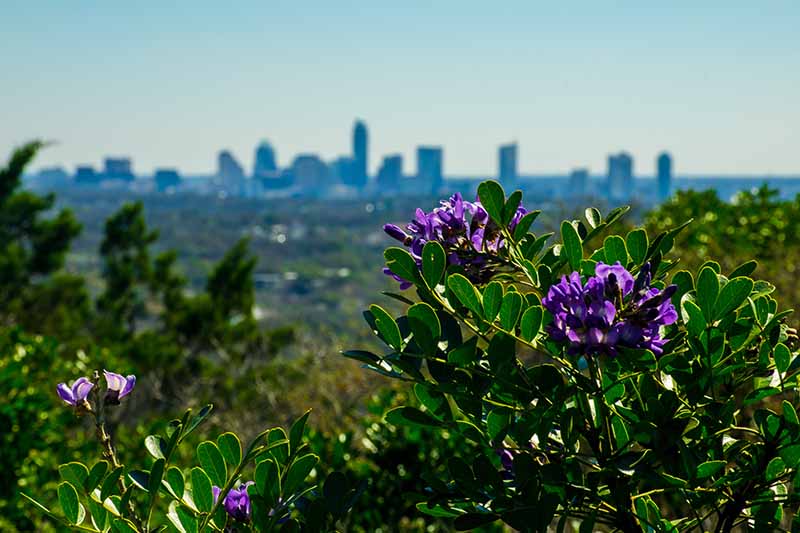
This yellow-bodied immature moth can strip the leaves off a Texas mountain laurel in no time flat, though the foliage almost always grows back and the plant suffers no permanent damage.
The caterpillars form loose webbing on the plants they’re decimating.
Control these one-inch-long snackers with Bacillus thuringiensis.
Best Uses for Texas Mountain Laurel
Texas mountain laurel makes a lovely specimen tree or shrub, which is primarily how I see them grown in Austin.

You can also create a tall screen with these, by planting several in a row and letting them bush out.
Quick Reference Growing Guide
| Plant Type: | Shrub | Flower / Foliage Color: | Purple; dark green |
| Native to: | Texas, New Mexico, Mexico | Maintenance: | Low |
| Hardiness (USDA Zone): | 7b-11 | Tolerance: | Rocky soil, drought |
| Bloom Time / Season: | Late winter, early spring | Soil Type: | Poor to average |
| Exposure: | Full sun to partial shade | Soil pH: | Above 7.2 (alkaline) |
| Spacing: | 10 feet | Soil Drainage: | Well-draining |
| Planting Depth: | Seeds: 1/2 inch; transplant: same depth as root ball | Water Needs: | Minimal |
| Height: | 15 feet | Uses: | Specimin or screen |
| Spread: | 10 feet | Family: | Fabaceae |
| Growth Rate: | Slow | Genus: | Dermatophyllum |
| Attracts: | Butterflies, bees | Species: | secundiflorum |
| Common Pests: | Genista caterpillar (also known as sephora worm) | Common Disease: | Root and crown rot |
A Rose of a Different Name
Gardeners looking for a tough evergreen tree or shrub that perfumes the air each spring with a floral scent that stops traffic should consider Texas mountain laurel.
Lousy soil? No rain for weeks? Hungry deer? No problem. D. secundiflorum takes it all and comes out smelling like a… glass of grape Kool-Aid?
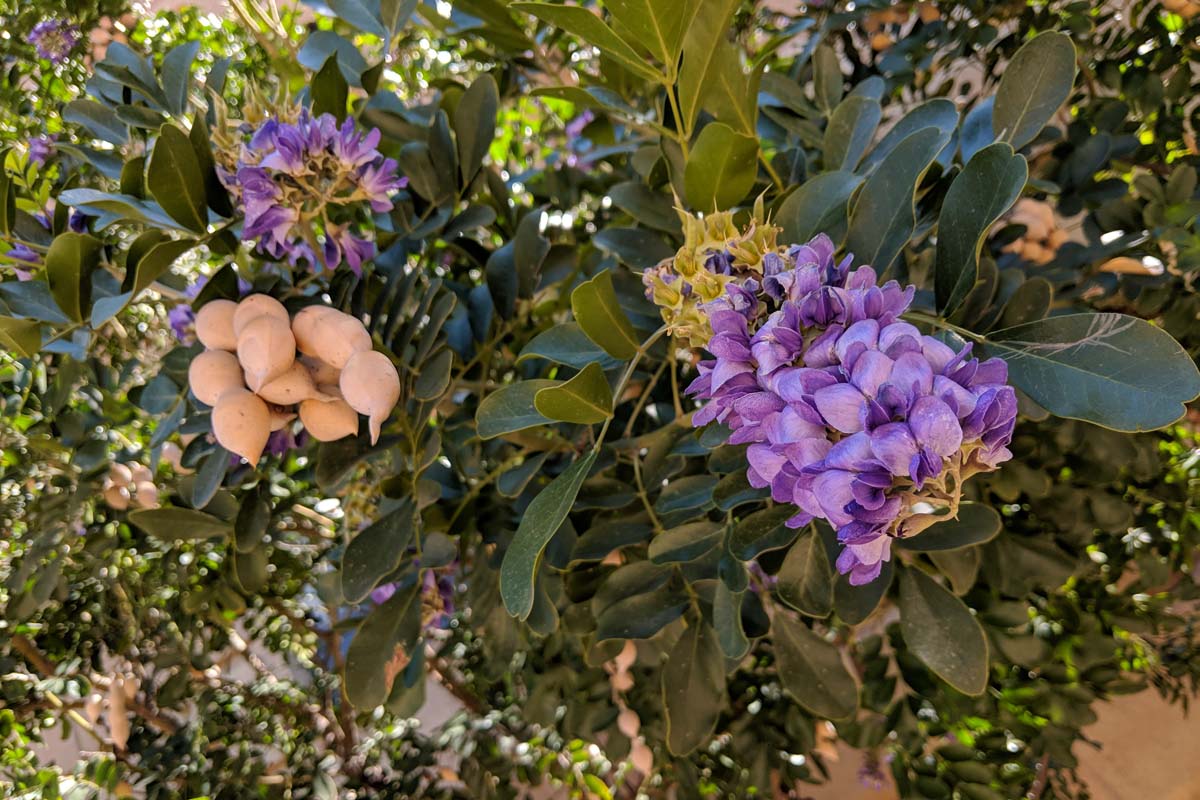
Have you grown Texas mountain laurel? Share your tips and thoughts in the comments section.
If you’d like to learn more about growing other shrubs, check out these articles:




I loved reading this!!
question? Will the roots work there way through my pool wall?? Is there a good/ better location for planting when it comes to a pool?
thanks for your feedback!
Julie
These roots seem to mostly grow straight down and not so much to the sides…but Check into that further.
Normally my Mountain Laurel is blooming in February, but not this year. Is that a sign of a late Spring like watching for Pecan trees to bud?
Hello Claire! I love the thought, but I don’t know that I would consider it an annual ritual to time spring’s arrival via the blooms. It is possible for Texas mountain laurel to vary a little on its blooming schedule, though. There’s also a chance that the buds succumbed to early freezes this year, but that’s not too likely since it hasn’t happened before. I did want to mention that something could have changed for your Texas mountain laurel this season without your realizing it. For example, for a strong show of blooms, it needs six to eight hours of… Read more »
I planted a smaller one late last year. It lived through the winter but the leaves are light green even though it has gotten plenty of water. I feel like it is stressed, and I’m wondering if the light green is normal?
Hello Douglas G!
The light green leaves may just be characteristic of that particular plant. I would keep up with the good watering, making sure it’s in well-draining soil. And watch for any spots on the leaves that could indicate an ailment.
But if there are none, the “wait and see” approach is best here. Also, if you want to post a picture of the leaves that would help me and the other readers compare them to Texas Mountain Laurels we’ve seen that are healthy. Good luck!
I have a Texas mountain laurel that was planned about 18 months ago. We are trying to prune it into a tree. When is the best time to remove the center stake it is tied to? It seems very top heavy compared to great strength of the trunks but has outgrown the stake I originally had. I’m wondering if it is better to let it be on its own or to restake it.
I have mature Texas mountain laurel all over my ranch. I have just begun air layering on the bottom branches to start new plants as well as trim the plant into a tree. Has anyone had success with this method? New roots should appear by the end of June, I’ll keep y’all updated on the project and am happy to hear your stories as well. I’m located in Bandera. Y’all have a great day!
Hello to you and all your fellow gardeners in Bandera, GTB! We’ll be looking forward to updates on this air layering project. Best of luck!
Newly planted Texas Mountain Laurel Leaves are turning yellowish. It has been quite rainy this summer, but has been watered regularly when not raining. Have we been over watering? It gets plenty of sun on the west side of the house.
Is the tree showing any other symptoms, and the does the soil drain well? Overwatering can lead to root rot in oversaturated soil, but yellowing can be a symptom of underwatering as well.
We received a sapling from my in-laws last year and has survived the winter in the pot in our patio. I’m ready to plant, but we have heavy clay soils. Any suggestions on amending the soils. Or should I plant it and hope for the best?
Though these trees can do well in clay, amending at planting time with compost to improve drainage is recommended if the soil does not drain well.
What is the best time of year to plant a Texas mountain laurel?
Hello Donna! Plant a Texas mountain laurel in early to mid-winter, when it’s dormant. If you’re trying to plant seeds, which is not recommended since they don’t sprout readily, it’s best to make the attempt in the early spring, while understanding that they can take a year to germinate. Good luck with your Texas mountain laurel!
You say plant 10 feet apart. Is that 10 feet from another tree or 10 from shrubs too?
Ten feet of space from all surrounding plants and structures is a good rule of thumb to follow to provide space for plants to grow to maturity and to allow for proper airflow.
Our TX Mountain Laurel is 4 years old and has gotten taller, but the trunks don’t stand well on their own. If we don’t keep them banded together, they just fall over. Otherwise, the plant seems very healthy. Can you help, please? My husband is tired of messing with it and I don’t want him to give up.
Hello Donna! I’m sorry you’re struggling a bit with your mountain laurel, but also glad you’re not willing to give up! For starters, it’s great that the plants are healthy. And while it might be the opposite of what you’d expect me to recommend, I would keep them banded until they stop blooming this year, and then carefully prune them back. The rule of thumb is about a third of the height. This should help the shrub get a bit stockier. Good luck and if you’re able, please share photos so we can all enjoy the transformation.